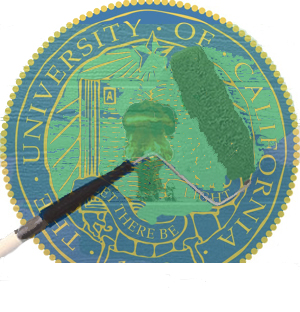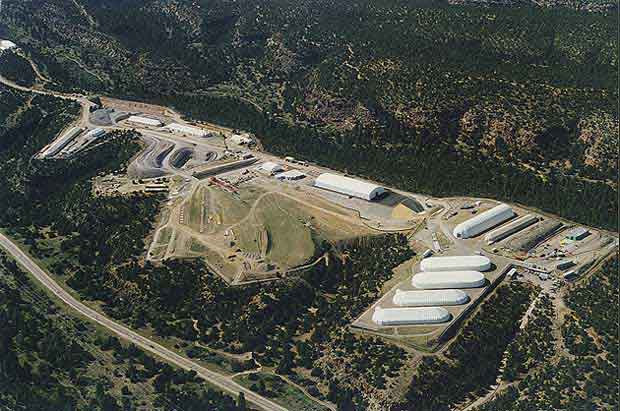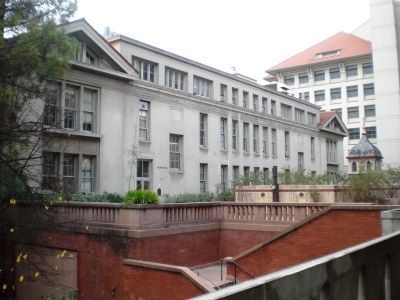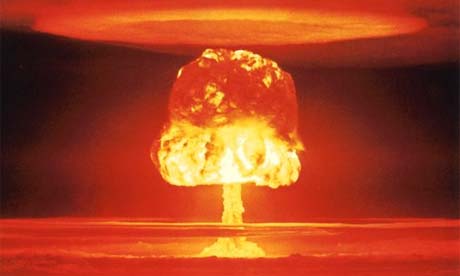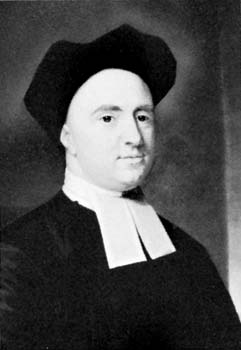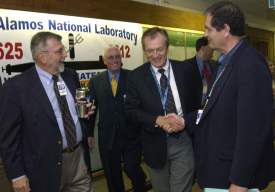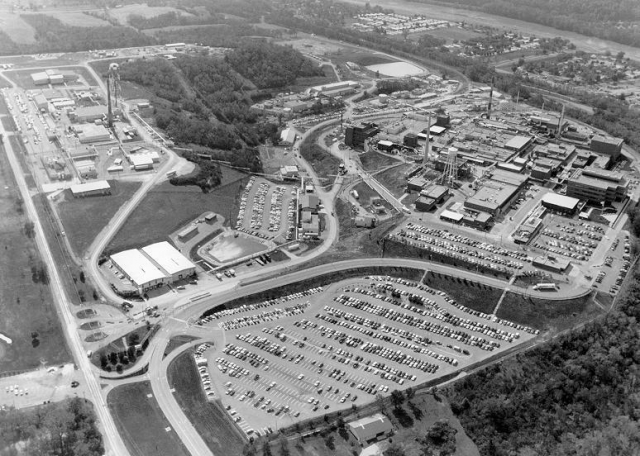From the Open-Publishing Calendar
From the Open-Publishing Newswire
Indybay Feature
We wrote the following essay roughly 18 months ago, as a draft of a chapter in our forthcoming book on the role of modern research universities in developing what we call the “technical intellectual resources” that enable global capitalist imperialism. The book focuses particularly on the University of California and its relationship with the nuclear weapons development labs at Los Alamos, NM, and Livermore, CA. ... Our intention in publishing it at Indybay is to generate a greater level of critical reflection and discussion concerning the dominant role of the politics of “greening” and communitarian “collaboration-with-decision-makers” approaches that characterize campus-based environmental organizations as well as an increasing number of those in the greater American body politic.
We wrote the following essay roughly 18 months ago, as a draft of a chapter in our forthcoming book on the role of modern research universities in developing what we call the “technical intellectual resources” that enable global capitalist imperialism. The book focuses particularly on the University of California and its relationship with the nuclear weapons development labs at Los Alamos, NM, and Livermore, CA. The current working title is Atomic Trust: The University of California, Nuclear Weapons, and the Eternal Manhattan Project. Because the essay will no longer be included in the book, we have opted to post it here at Indymedia. We have only slightly updated the essay; thus, some of the information and references it includes may be outdated. Our intention in publishing here it is to generate a greater level of critical reflection and discussion concerning the dominant role of the politics of “greening” and communitarian “collaboration-with-the-powers-that-be” approaches that characterize campus-based environmental organizations as well as an increasing number of those in society at large. We can think of few more timely priorities for those who would use university campuses as organizing bases to challenge the system of authoritarian power that is in the process of destroying the ecological basis for the existence of life on earth. “We must name that system,” as a student radical named Paul Potter stated in a different context nearly 35 years ago. In short, we offer this essay as a starting point toward naming the role of modern research universities in perpetuating ecological holocausts large and small.
“Was the Cold War the Earth's worst eco-disaster in the last ten thousand years?” -- Mike Davis, urban ecologist at UC Irvine
“Fuck you!” – UC Regents Chairman Richard Blum, responding to a student protester during a June 2007 meeting at the Santa Barbara campus (students had briefly disrupted the meeting in protest of the Regents’ policy on public comment, cutting the period for input short).
In October 2007, the magazine of the country’s longest-running conservationist organization, the Sierra Club, published its inaugural listing of the country’s “greenest campuses.” The rankings were assigned based on each campus’ building designs, energy policies, bike facilities, and food purchasing contracts. The idea was to capture the total ecological impact of universities in one simple ranking system. Proudly coming in at Number 4 – the highest ranking of any public university -- was the University of California. The only universities dubbed more eco-friendly by the magazine’s editorial staff were Oberlin College in Ohio, Harvard University, and Warren Wilson College in North Carolina.
In the areas under consideration, the UC really is impressively “green.” In June 2003, the Regents approved a policy committing the UC system to generating ten megawatts of solar power by 2014, the equivalent of roughly one-seventh of the US’ entire solar energy industry at the time. The Regents have also mandated an increase of so-called “low- to zero-emission vehicles” (placed in quotations here because it is a misnomer*). The UC is even committed to achieving “zero waste” by 2020.
“Zero waste” – we’ll begin there. So long as the UC is a manager of LANL and LLNL, to call it a “zero waste” institution would be akin to labeling McDonalds a vegetarian restaurant now that it’s added salads to its menu. The UC co-manages the largest nuclear waste dump in New Mexico, the state with the largest concentration of nuclear weapons activity in the United States. This dump is labeled “Area G,” and it is located on the southeast end of the Los Alamos compound, roughly adjacent to the San Ildefonso American Indian reservation.
Area G is massive and expanding. As of 2003, enough buried radioactive and chemical wastes were stored there to fill 1.4 million 55-gallon drums, as well as 60,000 drums' worth of temporarily-stored waste. Overall, there are roughly 400,000 cubic feet of plutonium-contaminated [“transuranic”] waste housed at the facility, much of it generated by LANL’s own nuclear weapons activities. If LANL’s trajectory to become the main site of plutonium pit production in the US moves forward – at any capacity at all – then this nuclear waste dump is set to receive huge infusions of toxic and radioactive material. These wastes are interred without liners or caps, in bulldozed “pits.” That they are leaking is a virtual certainty.
The vast majority of nuclear waste dumped into Area G has been during UC’s sole operation of LANL. This makes the University of California one of the largest nuclear waste dumping entities on Earth. Few other corporations or even nation states can claim to have produced and dumped more radioactive materials into the environment.
Plutonium: For humans and other living creatures, it is demonstrably the most toxic substance on Earth. According to some estimates, as little as 10 millionths of a curie of this most horrific of substances, if inhaled, can cause human cancer. If this figure is accurate, that means enough lethal doses have been generated worldwide to give cancer to every man, woman, and child on earth millions of times over. There can perhaps be no clearer illustration of Lewis Mumford’s axiom that “national security,” particularly at this late stage of high-technology civilization, really means “organized suicide.”
That this microscopic grim reaper of the atomic age, as well as the means to use it in nuclear weaponry, was nurtured into existence by UC scientists should come as no surprise given the larger configuration of power that determines the direction of the university’s research agenda. In 1941, a UC Berkeley scientific team led by physics professor Glen Seaborg became the firs to isolate plutonium isotopes, in Berkeley's Gilman Hall. The next step to “weaponizing” the new substance (to use a military term of trade) was to engineer a new kind of crucible with a high enough melting point to contain molten plutonium, one of the hottest substances known to humans. To design these implements, the federal government’s Manhattan Project team called on another UC Berkeley scientist, the chemist Leo Brewer. In the preceding years, Brewer had pioneered the field of inorganic chemistry at high temperatures. As with so many fields borne of militarized science, the possible applications of this discipline are almost entirely limited to military hardware: rockets, jet propulsion, and nuclear reactors. Within months, Brower’s team had developed a pilot plant to manufacture the rare element cerium and form it into crucibles for use in plutonium bomb cores.
Lest anybody who views atomic energy as a high altar of the cult of technological progress think otherwise, UC scientists did not isolate plutonium and design means of producing it en masse because of a disinterested pursuit of knowledge, or even through some quest to create purportedly “beneficial” technologies such as civilian nuclear power (although the latter was a bi-product of the UC’s nuclear weapons work). Rather, they did so in the context of a project to build weapons of mass annihilation. The innovations of Seaborg, Brewer and others led to development of the world’s first plutonium weapons by scientists at the UC-managed Los Alamos. The first of these, the “Trinity” bomb, was detonated in New Mexico in July 1945. The second instantly vaporized 70,000 human beings in Nagasaki on August 9, 1945 (Hiroshima was bombed on August 6, 1945, with an enriched uranium bomb, developed using the “Calutron” device developed at the UC in 1942). The UC nuclear weapons labs have consistently pioneered the use of plutonium in thermo-nuclear weaponry in the more than six decades since.
Seaborg’s team named plutonium aptly. (Coincidentally, the British team that concurrently isolated the element proposed the same name). Named after Pluto, the Roman god of Hades, or the underworld, plutonium embodies some of the darker qualities associated with its mythological namesake. Pluto etymologically comes to us from the Greek word Plouton, meaning wealth. Precious metals come from the earth, thus Pluto’s association with them. Pluto is portrayed in some mythology as a millionaire king, surrounded in his underground court with gold, silver, and we should suppose uranium and plutonium. The god of the underworld oversees the realm of the dead. Death and wealth, destruction and power, the meanings intertwine and we are left with deadly substances such as plutonium and deadly social orders such as plutocracies. The UC’s role in creating plutonium is also a story about the production of immense power, wealth and death. Allen Ginsberg put it this way in his “Plutonian Ode”;
Hades, Sire of avenging Furies, billionaire Hell King worshipped once,
With black sheep throats cut,
Priests's face averted from underground mysteries in single temple at Eleusis,
Spring-green Persephone nuptialed to his inevitable shade,
Demeter mother of asphodel weeping dew,
Her daughter stored in salty caverns under white snow,
Black hail, grey winter rain or Polar ice, immemorable seasons before....
The future of the UC's weapons labs remains tightly bound to their most hellish substance. Currently, the DOE permits LLNL to host 3,180 pounds of plutonium on its premises (how much is actually stored there is classified), primarily for use in warhead design experiments -- the facility’s central initiative. As we have noted multiple times in the preceding pages, including once already in this chapter, LANL is on the verge of becoming the United States’ new plutonium pit factory, with all the attendant environmental desecration this will cause in New Mexico and beyond, thanks in no small part to lobbying by UC-appointed weapons labs administrators and personnel.
In the last half-decade scientists and administrators at both laboratories, but especially Los Alamos, have stoked controversies on the physical qualities of plutonium in hopes of creating the technoscientific basis for a resurgence of plutonium pit production. (US pit production ceased in 1989 with the closing of the Rocky Flats facility, a highly contaminated site run by several corporations over several decades producing the core nuclear components for the bomb.) Claiming that plutonium has an unstable crystalline structure that decays over short periods of time (approximately 40 years) some LANL scientists and administrators have purposefully spread fears within the press and Congress that the US stockpile of nuclear weapons was quickly becoming unreliable. Forget that there exists a stockpile of 24,000 working pits, some inside weapons, others stored in secure bunkers at the Pantex Plant outside of Amarillo, TX. Assuming the instability of plutonium’s crystalline structure were true would ensure the construction of a major new plutonium facility at Los Alamos Lab (which is moving ahead in fits and starts) and ensure the flow of billions of dollars to mill more bomb pits. Plutonium, however, has been demonstrated to become “more stable” over time and pits have been shown to have a “lifespan” much longer than the 40 years the nuclear weapons lobby has hoped to prove. In any case, the entire debate concerning plutonium pit “stability” is firmly grounded in the insane logic of nuclear technocracy; even if plutonium pits diminish over time, the nuclear weapons that contain them will remain utterly destructive for perhaps thousands, perhaps tens of thousands, of years to come.
The long-term consequences of what the UC has done (politically and technocratically speaking) to design and, increasingly, produce pits is summed up by Greg Mello of the Los Alamos Study Group:
“The U.S. has spent literally hundreds of billions of dollars to make [plutonium pits], and in the process has left behind a toxic archipelago of contaminated sites across several states, land that will never be fully restored for human use. Also left behind are the literally thousands of grieving family members who lost loved ones to radioactive contamination in the mines, mills, factories, test sites, and the communities surrounding them. No full accounting of the human or environmental cost has ever been made, and the Department of Energy (DOE) has spent more than a hundred million dollars fighting lawsuits initiated by survivors, environmental groups, and states.”
Both LANL and LLNL have a history of using their plutonium inventories to conduct both intentional and unintentional acts of ecocide, and attempting to cover up or rationalize those atrocities after the fact. The most striking example is the 215 atmospheric nuclear weapons bombings the UC nuclear weapons labs sponsored at the Nevada Test Site (NTS) and in the Marshall Islands between 1945 and 1963. Those detonations, combined with the Soviet Union’s 219 and the United Kingdom’s twenty-one test blasts during the same period, discharged five tons of plutonium into the atmosphere. This fact is especially shocking given that plutonium is most toxic as an inhaled substance; swallowing or touching it is far less deadly.
Some of the known public health and environmental consequences of these nuclear bombings include highly elevated rates of strontium-90 and cesium-137 in mothers’ breast milk and babies’ teeth, massive cancer clusters in the areas downwind of the tests (such as eastern Nevada and southern Utah), and nationwide contamination of cattle milk with Iodine-137. The tests deposited radioactive contamination across vast reaches of the planet, likely resulting in millions of premature deaths by causing birth defects, cancer, and other diseases.
In accordance with the 1963 Limited Test Ban Treaty, the weapons labs moved the majority of their testing at the Nevada Test Site underground, at which point the rate of testing only increased. It should be noted that the Test Site was located on land illegally seized from its native inhabitants, the Newe Nation (e.g., Western Shoshone). From 1963 until the present, the US has conducted over 800 underground nuclear detonations there. The scientific administrators maintained that these tests were completely safe; that no radioactive contaminants would escape from the massive underground shafts in which they were conducted. This notion completely defied logic, of course, if only given the tests’ extremely close proximity to Nevada’s underground water table. The lid was blown off of the claim, all too literally, in December 1970 when the contamination resulting from an Operation Emery explosion proved impossible to cover up. The detonation fractured the ground and leaked radioactive particles into the air, forming a large fall-out cloud in the atmosphere directly above. Winds spread the radioactive particles into twelve Western states, including California, and traces of radioactivity were detected as far north as the Canadian border. All told, underground tests like this one have left millions of curies of strontium, cesium, and plutonium underground, while releasing unknown quantities of these same radioactive toxins on a wide scale throughout the western hemisphere. Additional hundreds of thousands of cubic yards of radioactive waste have now been buried at the Nevada Test Site, a virtually permanent legacy of the UC’s nuclear weapons work imposed upon literally tens of thousands of future generations.
What of the unknown consequences of the serial nuclear weapons detonations? As former UCSC lecturer Valerie Kuletz wrote in her 1996 book on the American nuclear waste crisis, Tainted Desert:
"What effects has [radioactive contamination, particularly from nuclear weapons tests] had on our bodies and the biosphere? Aside from important early studies on health risks related to specific radiation contamination sites, no one has as yet come up with a way to verify in a comprehensive way the impact such a toxic environment has on the body. The Department of Energy says radiation from the activities of the nuclear industry has had no significant effect on our health and safety. But why does one in three Americans get cancer, and about 20 percent of us die of it? Why since the 1970s has cancer risen in the United States 18.6 percent for men and 12.4 percent for women?"
It would take a positively Strangelovian scientist to tell you that nuclear weapons experimentations have nothing to do with these alarming trends. One nuclear weapons scientist who did just that was none other than Edward Teller, the “Real Dr. Strangelove,” who contended in 1958 that radiation from fallout "might be slightly beneficial or have no effect at all." John Gofman, the former UC Berkeley and LLNL bio-physicist, was one of an unfortunately small cadre of weapons labs scientists who have repudiated previous denials of the danger borne by radioactive nuclear fallout. He stated in 1979:
"I am on record in 1957 as not being worried yet about fallout... There is no way I can justify my failure to help sound an alarm over these activities many years sooner than I did. I feel that at least several hundred scientists trained in the biomedical aspect of atomic energy -- myself definitely included -- are candidates for Nuremberg-type trials for crimes against humanity through our gross negligence and irresponsibility."
Framed in this light, it is mind-boggling that the vague argument of the UC as a “better” nuclear weapons lab manager than a private military-industrial firm still persists. We’re sure it would have been much “worse” if Lockheed Martin, instead of the UC, had virtually permanently irradiated our planetary ecosystem with plutonium and other radioactive “daughter” products of nuclear weapons. Praise be to Plutos that the UC Regents have seen fit to safeguard our “security” and the “public interest.” The entire track record of UC lab management has been one of secrecy, militarism and ecocidal production – a history that is virtually unparalleled by any military-industrial corporation. To claim that the UC has been a “better” manager flies in the face of reality: The UC has acted as a parastatal corporation to produce an arsenal of atomic weapons for the United States, and in doing so has polluted and destroyed vast expanses of the earth. How many corporations have ever perpetrated more ecological and social harm?
As the veritable “brain” of the US nuclear weapons complex, UC's LANL and LLNL scientists not only bear responsibility for the toxic pollution overflowing from their work on the “physics packages” of nuclear warheads; they have also created much of the market demand for the creation of these warheads, which means enabling the entire toxic process by which the warheads’ fissile material is generated -- uranium mining, uranium milling, and uranium enrichment, and then conversion of uranium into plutonium via fission in a nuclear reactor. All of these activities generate deadly wastes that emit radioactive decay products for thousands, millions, or – in the case of Uranium 238 -- even billions of years.
There is a safe solution for storing the radioactive material that the nuclear weapons complex and nuclear power industry have generated. Unfortunately, it was abandoned long ago. That solution was to leave uranium where it came from, in the earth, un-mined, un-milled, unrefined, and certainly not transformed into fissile materials like plutonium. It could have been left in Pluto's mythic underworld.
Instead, we now have “national sacrifice areas” -- a phrase coined by planners of the Nixon administration’s energy policy. These large swaths of the planet include the Great Basin of eastern California, Nevada, and western Utah, as well as the so-called "plutonium periphery" – the Columbia-Snake Plateau, the Wyoming Basin and the Colorado Plateau. Such has been the impact of the nuclear chain on these areas that parts of them will remain barren, poisoned, and largely uninhabitable – in the truest sense of the word, meaning that the water there is unsafe to drink and the soil is unfit for healthy food cultivation -- for perhaps thousands of years to come.
The truth is that these substances are so dangerous that the federal government has had to contract teams of anthropologists to design sign systems that will last tens of thousands of years into the future, warning future human communities not to dig or trespass on nuclear waste sites. At the Waste Isolation Pilot Plant (WIPP) in Carlsbad, New Mexico, a site where nuclear waste from LANL is shipped, one government-contracted team is building a “four-mile outer fence of dozens of 25-foot, 20-ton granite markers engraved with multi-lingual and pictographic warnings.” According to one report on this project:
“Inside that perimeter will be a massive earthen berm 33 feet high, forming a rectangle matching the footprint of the underground site. The berm will be implanted with magnets and radar reflectors to make it obvious that it’s not a natural formation. A structure in the center of the space and two subterranean rooms will hold detailed information on the facility, and hundreds of super-hard disks printed with pictographic danger signs will be scattered throughout its 120 acres.”
What of the UC’s connection with this project? According to documents released by the City of Carlsbad, a high-powered lobbyist closely linked with former Secretary of State Henry Kissinger, named Gary Falle, provided his services to bring the lucrative facility to southern New Mexico. What is Falle’s current occupation? The University of California Regents’ full-time lobbyist on behalf of the nuclear weapons labs in Washington, DC, under the title of associate vice president for federal governmental relations. It is only too often that the interests of the nuclear weapons, energy, and waste storage industries overlap, and that we find the UC politically and economically partnered with all three.
We can never know the full range of ecological atrocities the weapons labs have perpetrated, though more and more surface with fair regularity, in spite of the weapons labs and DOE bureaucracy’s best efforts . LLNL is on the federal “Superfund” list, meaning it is recognized as one of the most polluted sites in the country, with an “affected area” that includes seven million people. Since 1960, there have been more than thirty known releases of plutonium, uranium and other radioactive substances reported there. Dangerous quantities of tritium have ended up in Livermore wines. Plutonium sludge ended up in a local park where children play. LANL had produced 2,400 documented irradiated sites as of 1995, containing, as an article in The Nation put it at the time, "plutonium, uranium, strontium-90, tritium, lead, mercury, nitrates, cyanides, pesticides and other lethal leftovers.”
LANL and LLNL also have a long history of secretly and illegally incinerating irradiated wastes. One of the substances they have burned most often in the open atmosphere is Uranium-238, known misleadingly as “depleted uranium.” In the case of Livermore, these explosions occur at Livermore Site 300, located in the Altamont Hills between Livermore and Tracy. In July 2007, LLNL applied to raise the permissible limit of the radioactive materials its scientists detonate there from 1,000 to 8,000 pounds annually.
Perhaps there is no correlation between LLNL’s activities and the fact that breast cancer rates among San Francisco Bay Area women have been among the highest in the world, or that thyroids cancer rates are likewise overwhelmingly high. Perhaps the marine dump just 50 miles offshore from the city, outside of the Farralon Islands, has no relation to human health along the California coast. We have little way of knowing. A sorrowfully wry quote by the author and southern Utah native Terry Tempest Williams in the essay “Clan of the One-Breasted Women” comes to mind: “I cannot prove that my mother, Diane Dixon Tempest, or my grandmothers, Lettie Romney Dixon and Kathryn Blackett Tempest, along with my aunts, contracted cancer from nuclear fallout in Utah [downwind of the Nevada Test Site]. But I can't prove they didn't."
We have several irrefutable examples by now of the intergenerational effects of ionizing radiation. Children of northern Ukraine born after the 1986 Chernobyl nuclear reactor accident show far greater incidence of birth defects than those born at the time of the accident, as have children born in Hiroshima and Nagasaki after 1945. The number of Chernobyl cancer cases was only expected to peak recently, more than twenty years after the incident occurred.
For this and many of the other reasons we have outlined, the eco-feminist and largely excommunicated former National Science Foundation epidemiologist Dr. Rosalie Bertell postulated in the early-1980s that nuclear contamination is already so pervasive as to have instigated an irreversible process of “species suicide”: the eventual premature extinction of life on the planet due to the total contamination of our ecosystem by the radioactive byproducts of the nuclear industry. It might seem, on the surface, that she is exaggerating. But Bertell’s analysis points to a stark reality that the UC’s nuclear weapons labs, in conjunction with the larger national security state, have wrought: All life has, collectively, been rendered unwilling guinea pigs of the atomic age.
The Sierra Club’s high ranking of the UC as a “green” institution is deeply telling. The fact that the Sierra Club seems to think so much of “campus greening” as a political strategy is even more so.
Campus greening is all well and good. To our mind, anything that promotes even a slim margin of greater ecological balance and sanity has at least some degree of validity. Certainly, the installation of more solar panels, creation of alternatives to petroleum products, composting of food scraps, industrialized recycling of capitalism’s waste products, and various other tactics utilized by the mainstream environmental movement to reduce humanity’s “ecological footprint” – another calculus of progress toward sustainability that has gained widespread acceptance – are offsetting some of industrial capitalism’s most severe ecological ravages. However, to attend purely to some aspects of the university’s ecological impact while ignoring other, more systematic impacts is incredibly irresponsible.
The greening of the UC has in large part been an initiative of an amazing coalition of students, staff, faculty and NGO allies. Through years of campaigning they have achieved programmatic commitments from the UC Regents to make considerable steps toward making the UC an incrementally more sustainable institution. This success is underpinned by decades of dedicated organizing and a profound cultural shift that has given legitimacy to the goal of sustainability. It must be pointed out, however, that even with these new policies, the UC today is an immensely unsustainable institution consuming inordinate quantities of energy and resources, to say nothing of the technological horrors many of its labs are hard at work producing.
The campus environmental movement’s focus on “greening” the university is strongly counter-productive in most respects. So, too, is that of the mainstream environmental movement of which these campus organizations are largely a microcosm. “Greening” is based on the assumption that reforming industrial capitalism can foster a sustainable and balanced relationship between humanity and the planetary ecosystem on which our collective existence is based. It cannot. It is also based on coddling up to authoritarian leaders and corporate executives and beseeching them to implement a narrow set of the sane and constructive changes the world needs. In reality, these individuals are not capable of implementing the far more important measures that would truly benefit our total environment, nor are the overwhelming majority of them interested in doing so. Simply put, the world’s ruling elite will never change unless they are forced to.
However, the process and image of greening and making institutions more environmentally sustainable suits many goals of the ruling elite. Greening helps to legitimate corporate power, be it that of the university or Exxon Mobile. A few small steps this way and that can go very far to gloss over a corporation’s image and hide ongoing environmental crimes. Greening obscures the inherently destructive aspects of industrial capitalism by emphasizing small reforms and innovations while ignoring core processes.
It may seem far-fetched to compare the “greening” of the UC to that of a company that has not only extracted, produced, and refined literally billions of barrels of petroleum, but has made denial of global warming into a veritable cottage industry among the pseudo-scientists on its dole. If so, consider the following. For more than a century, UC geologists, engineers, and organic chemists have been at the forefront of developing new petroleum technologies that have led to the extraction of tens of billions of barrels of oil than otherwise would not have been possible. To take but one instructive example, the widely acknowledged pioneer of petroleum engineering education in the United States, Lester Uren, was a Professor of Petroleum Engineering at Berkeley for more than 40 years. He developed the nation’s first university-level course on petroleum engineering and also wrote the field’s definitive textbook. As the Hearst Corporation-owned magazine Popular Science wrote of Uren in 1934, “He and his colleagues have found in their laboratories means of giving new life to depleted fields, and thereby have added fully a half-century's supply to the fifteen-year supply available by present methods." Not coincidentally, several of the most powerful members of the UC Board of Regents in the last 100 years have been oilmen, including Edwin Pauley (for whom Pauley Pavilion at UC Berkeley is named) and Samuel Mosher (for whom UC Santa Barbara’s Mosher Alumni House is named), both of whom were members of the US National Petroleum Council -- the one-time presidential advisory group that serves as the primary de facto lobbying interest in Washington on behalf of Big Oil.
Let’s pick another leading source of environmental degradation verging on ecological holocaust and trace the UC’s instrumental contributions to it. How about genetically-modified foods? It so happens that the world’s leading peddler of GMO produce, Monsanto, owns a California subsidiary named CalGene. CalGene developed the first genetically engineered food to be granted a license for human consumption, the FlavrSavr Tomato. Notably, the FlavrSavr was brought to market despite the fact that rats that ate the tomatoes in a pair of pre-market health trials developed fatal stomach lesions. How did the company’s technological raison d’etre come about? The answer is that it was a spin-off of research at UC Davis’ Division of Biological Sciences. In fact, for precisely that reason, CalGene is headquartered less than a mile from the Davis campus, which has been at the forefront of a wide range of agricultural biotechnology research for roughly two decades.
How about toxic chemicals? The list developed by UC researchers is long and includes the notorious DBCP, a deadly pesticide that has been banned in California – though not in other parts of the world -- due to its catastrophic public health impacts. Deforestation? The UC’s Cooperative Extension program conducted research on behalf of multi-national timber interests destroying ecosystems in northern California for decades. Agrofuels? The British Petroleum-sponsored Energy Biosciences Institute at UC Berkeley positions the UC on the leading edge of the development of new agrofuel technologies that are ostensibly geared toward creating more environmentally friendly forms of motor transport, but will invariably result in the increased conversion of what remains of the earth’s most vibrant ecosystems into barren monocrop agricultural plantations geared toward feeding the gaping maw of industrial capitalism. Mass starvation and displacement of rural peoples the world over will only increase.
This list could go on for pages.
What is important here is not to relate a list of self-enclosed historical information having to do with the UC’s participation in environmental crimes. Instead, it’s to connect the dots between all of these seemingly disparate examples; in other words, to analyze what it is that makes the university a fundamentally unsustainable institution. To that end, it behooves us to ask a basic question: What is the University of California?
The University of California was created in 1868 as a college for mechanical arts and agriculture. From its first days the main missions of the UC were practical and applied. The UC has always been an educational and research institution administrated to the benefit of California’s power elite. Even today, the UC’s publicists describe it first and foremost in terms that emphasize the economic functions. According to the UC’s official web site:
“UC researchers are pioneers in agriculture, medicine, technology and the environment. Thousands of California jobs, billions of dollars in revenues, and countless everyday household items – from more plentiful fruits and vegetables to compact fluorescent light bulbs – can be traced back to UC discoveries. Similarly, many of the state’s leading businesses have connections to UC. Those companies were either based on technology developed by the university, were founded by our faculty or alumni, or are headed by UC graduates.”
The Constitution of California is quite clear about these defining characteristics of the university, especially its subordination to the needs of for-profit businesses. The UC's precursor, the College of Agricultural, Mining and Mechanical Arts was established by the state legislature in 1866. The school's function is right there in its name: agriculture, mining and mechanical arts. The school was dedicated to advancing the practical needs of rapidly expanding extractive enterprises that were sweeping across the state during the latter half of the 19th century. This of course necessarily coincided and synergized with the genocidal murder and displacement of Native Peoples from the land, rivers and mountains sought by the Anglo-American settler colonists. The Morrill Land Grant Act of 1862 had given lands to the states, the sale of which would provide funds to maintain state colleges. It required not only that courses in mechanics and agriculture be offered, but also military tactics.
In 1868 the Organic Act established the UC and put economic and ideological functions front and center for the new school. Furthermore, this legislation militarized the university from day one, requiring that: "able-bodied male students of the University, whether pursuing full or partial courses in any college, or as students at large, shall receive instruction and discipline in military tactics."
The UC was founded near the end of what was the most brutal period of colonization in the history of the continental US. The philosophical basis for that colonization was “Manifest Destiny,” the idea that the US’ imperialistic westward expansion was divinely ordained by a benevolent Christian God. Thus, it is deeply telling that the UC’s founders named its first campus after the philosopher and cleric George Berkeley, whose lyrics concerning the divinely-ordained nature of westward imperial expansion, in the poem “America: A Prophesy,” are often credited as inspiring Manifest Destiny. That many UC campuses are built on the sites of former American Indian villages, ceremonial grounds, and burial grounds further indicates the link that the UC has to this mostly forgotten and disavowed process of extermination.
The UC was forged in a somewhat different California than that to which most of us are accustomed: a California being tamed, tapped and trampled by miners and cattlemen, planters and railroad magnates, and all assortment of robber barons set on ripping wealth from the land by any means necessary. These men needed new technologies to facilitate extraction of minerals and plantation agriculture on massive scales. They also needed ideology to justify the political projects of conquest, war, and eugenics that their economic dreams required. The political-economy of the state of California was designed to produce these expedients early on, with the UC serving at the primary motor of its technocratic machinery. In particular, California’s Central Valley became a massive plantation ringed by mountains mined for gold and other precious metals, later to be converted into arguably the global epicenter of US agribusiness and dotted with the largest known array of prisons in the western hemisphere.
Based on this brief sketch of the UC’s early history, coupled with the other information we have outlined, the view emerges of the university as a primary hand-maiden to the most ecologically (and socially) destructive political and economic system ever devised: industrial capitalism.
[We continue our critique of greening, of capitalism, and of the UC in Part II, published next Sunday, April 12.]
We are 100% volunteer and depend on your participation to sustain our efforts!
Donate

$220.00 donated
in the past month
Get Involved
If you'd like to help with maintaining or developing the website, contact us.
